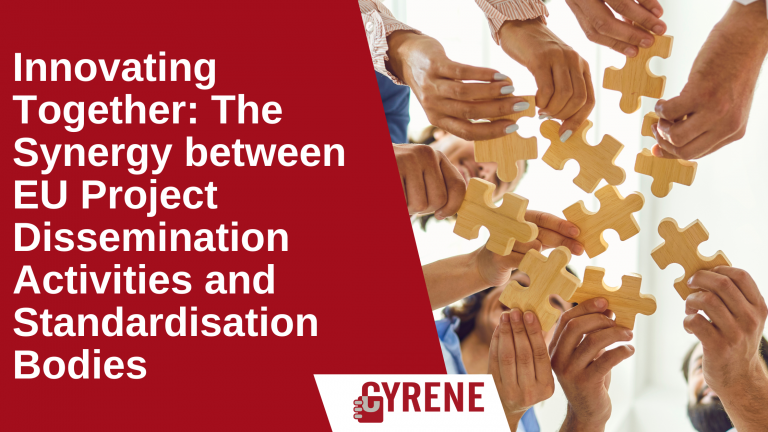In today’s interconnected world, collaboration plays a crucial role in driving innovation, particularly when it comes to large-scale European Union (EU) projects. EU projects often span multiple countries and involve various stakeholders, including public and private organisations, academic institutions, and research centers. Consequently, the sharing of knowledge, expertise, and best practices becomes essential to ensure the success of these projects and maximise their impact on society.
Standardisation bodies are key players in this collaborative environment. By developing and promoting harmonised standards and guidelines across different industries and sectors, these organisations facilitate interoperability, compatibility, and seamless collaboration between diverse solutions and technologies. This blog post explores the synergy between EU project dissemination activities and standardisation bodies and examines the benefits of their collaboration for innovation and the overall success of EU initiatives.
The Significance of Dissemination Activities in EU Projects
Dissemination activities are essential components of EU projects, as they help to share information, increase awareness, and promote the adoption of innovative solutions. These activities enable project partners to share their knowledge, experience, and best practices with stakeholders, the wider public, and other interested parties. By doing so, EU projects can foster collaboration and create a knowledge network that spans multiple disciplines and sectors.
Moreover, effective dissemination activities can contribute to the long-term success of EU projects. By raising awareness of project achievements and their potential societal, economic, and environmental impacts, these activities encourage stakeholders to integrate project results into their policies, strategies, and practices. In turn, this can lead to broader adoption and implementation of innovative solutions and contribute to addressing pressing challenges faced by the EU and its member states.
The Crucial Role of Standardisation Bodies in Fostering Innovation
Standardisation bodies are integral to the successful implementation of EU projects, as they develop and promote harmonised standards and guidelines that facilitate interoperability and collaboration between various solutions and technologies. By working closely with EU projects, standardisation bodies can ensure that project outcomes align with existing and emerging standards, which in turn can help to enhance project impact, facilitate market access, and instill confidence in stakeholders.
Furthermore, collaboration with standardisation bodies can lead to the identification of new areas for research and innovation. As these organisations are often at the forefront of technological advancements and evolving industry requirements, they can provide valuable insights and guidance for EU projects. This collaboration can help to identify knowledge gaps and emerging trends, thus shaping the direction of future research and innovation activities.
Leveraging Synergies for Greater Impact and Success
The synergy between EU project dissemination activities and standardisation bodies can result in numerous benefits for both parties, as well as the broader EU community. By sharing knowledge and expertise, EU projects and standardisation bodies can learn from each other, thus accelerating the development and adoption of innovative solutions.
For instance, EU projects can contribute to the development of new or improved standards by sharing their research outcomes, best practices, and lessons learned with standardisation bodies. This exchange of knowledge can help to ensure that standards and guidelines are based on the latest research and technological advancements, ultimately leading to higher quality solutions and greater market acceptance.
Conversely, standardisation bodies can support EU projects by providing guidance on relevant standards and regulations, thereby facilitating market access and reducing technical barriers to trade. By adhering to established standards, EU projects can demonstrate their commitment to quality, safety, and efficiency, thus building trust and credibility among stakeholders.
The synergy between EU project dissemination activities and standardisation bodies is a vital component of the success and impact of EU initiatives. By working together, these entities can foster innovation, accelerate the adoption of novel solutions, and facilitate the development of harmonised standards and guidelines that address the diverse needs of various industries and sectors. This collaborative approach not only strengthens the individual efforts of both EU projects and standardisation bodies, but also enhances their collective impact on addressing pressing challenges faced by the EU and its member states. Ultimately, this partnership paves the way for a brighter, more sustainable, and innovative future for Europe and beyond
KEY FACTS
Project Coordinator: Sofoklis Efremidis
Institution: Maggioli SPA
Email: info{at}cyrene.eu
Start: 1-10-2020
Duration: 36 months
Participating organisations: 14
Number of countries: 10
FUNDING
 This project has received funding from the European Union’s Horizon 2020 Research and Innovation program under grant agreement No 952690. The website reflects only the view of the author(s) and the Commission is not responsible for any use that may be made of the information it contains.
This project has received funding from the European Union’s Horizon 2020 Research and Innovation program under grant agreement No 952690. The website reflects only the view of the author(s) and the Commission is not responsible for any use that may be made of the information it contains.


